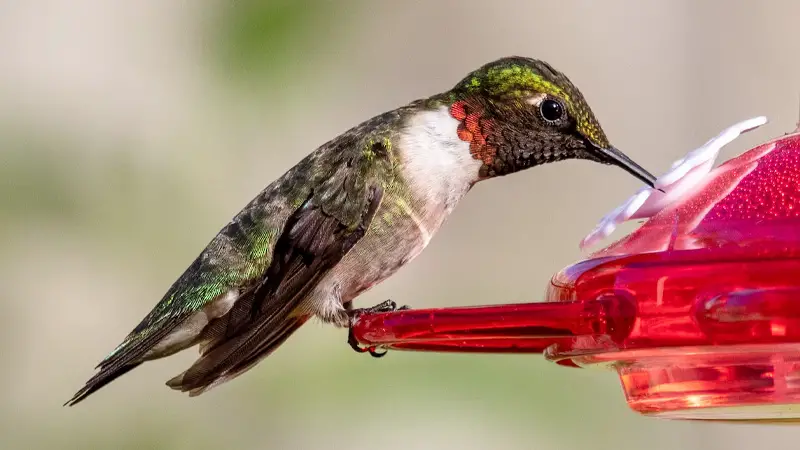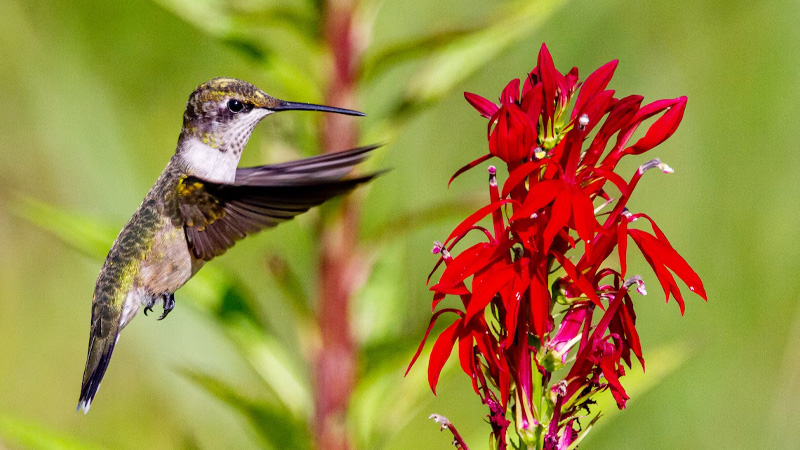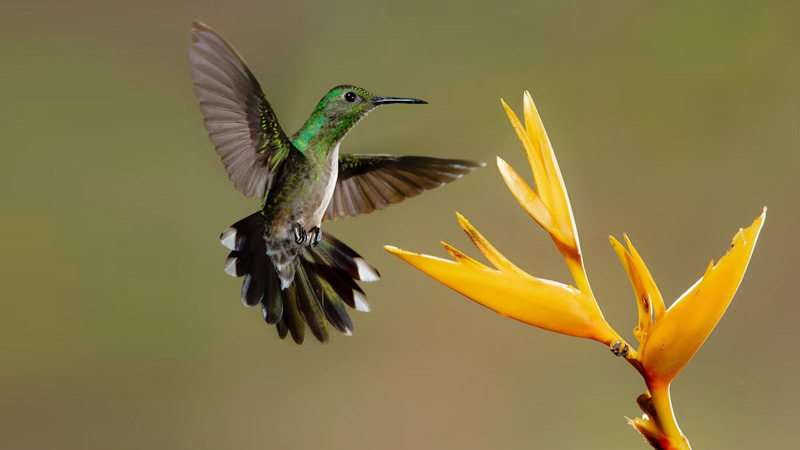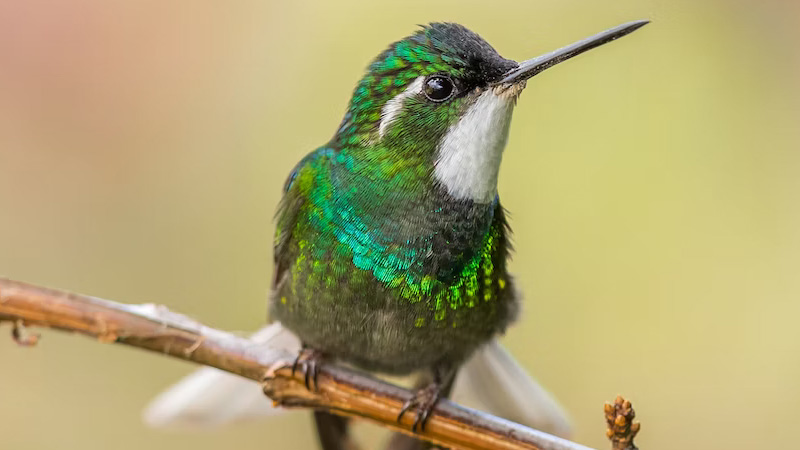Hummingbirds are renowned for their incredible agility, swift movements, and their vibrant, iridescent feathers that seem to shimmer in the sunlight. These tiny birds are a delight to watch as they flit from flower to flower, sipping nectar with their specialized beaks.
But have you ever wondered if hummingbirds can appreciate the same vibrant colors that we do? Are they able to see the world in all its glorious hues?
In this article, we’ll explore the fascinating topic of hummingbird vision and delve into the question: Are hummingbirds color blind?

Are Hummingbirds Color Blind?
To answer the question of whether hummingbirds are color blind, it’s important to first understand how their visual system works. Hummingbirds have a keen sense of vision that is vital for their survival and their ability to locate food sources, navigate their environment, and identify potential mates.
Color Perception in Hummingbirds
Contrary to popular belief, hummingbirds are not color blind. They possess a remarkable ability to perceive a wide range of colors. In fact, they can see colors that are beyond the capabilities of the human eye.
This remarkable color vision is due to the presence of specialized cells in their eyes called cones.
The Role of Cones in Hummingbird Vision
Cones are photoreceptor cells in the eyes that enable the perception of colors. Humans have three types of cones that are responsible for sensing red, green, and blue light.
However, hummingbirds have an additional type of cone that allows them to perceive ultraviolet (UV) light, which is invisible to humans.
The Importance of Ultraviolet Vision
The ability to perceive UV light is particularly significant for hummingbirds as it helps them locate nectar-rich flowers. Many flowers have distinct UV patterns, invisible to humans, that guide the birds towards the sweet nectar they seek.
By perceiving these UV patterns, hummingbirds can easily identify the most rewarding flowers, ensuring an efficient energy intake.
Iridescent Feathers and Mating Displays
Hummingbirds’ iridescent feathers are not only a visual treat for humans but also play a crucial role in their courtship and mating displays. The iridescence is a result of light interacting with microscopic structures in their feathers, creating a stunning display of shimmering colors.
This dazzling spectacle is perceived by potential mates, helping them assess the health, vigor, and attractiveness of the displaying bird.
The World of Hummingbird Colors
While hummingbirds can perceive a wide range of colors, it’s worth noting that their vision is not identical to that of humans. The colors they see may differ slightly, and certain shades may appear more or less vibrant to them.
Nonetheless, their ability to detect and appreciate colors is far from color blindness.
What Colors Do Hummingbirds See Best?

Hummingbirds have a particular affinity for certain colors, which they can see and perceive with exceptional clarity. While they have the ability to detect a wide range of colors, there are specific colors that tend to attract them more.
The following colors are known to be particularly appealing to hummingbirds:
Red
Hummingbirds are strongly attracted to red. Red flowers, such as tubular red blossoms, hold a special allure for them. This attraction is due to the fact that many red flowers are rich in nectar, which serves as a vital energy source for these tiny birds.
Orange
Along with red, orange is another color that hummingbirds find highly attractive. Flowers with vibrant orange hues, such as trumpet-shaped blooms, are often visited by hummingbirds seeking nectar.
Pink
Hummingbirds are also drawn to flowers with pink petals. Soft pink shades can catch their attention and serve as a visual cue for potential nectar sources.
Purple
Purple flowers, including shades of lavender and violet, are particularly appealing to hummingbirds. These colors can act as beacons, signaling the presence of nectar-rich flowers.
It’s worth noting that while these colors tend to be more attractive to hummingbirds, they are not the only colors that these birds visit. Hummingbirds have been observed visiting flowers of various colors, including white and yellow.
The specific shades and patterns of the flowers, along with other factors such as scent and nectar availability, also influence their preferences.
Additionally, the iridescent feathers of male hummingbirds, which can display a range of vibrant colors, play a crucial role in attracting mates during courtship displays.
These dazzling displays showcase the birds’ brilliant plumage and can incorporate a combination of colors such as green, red, and blue.
What Are Some Examples of Colors That Hummingbirds Might Not See?

Hummingbirds have an impressive ability to perceive a broad spectrum of colors, including those beyond the range of human vision.
However, there are some colors or color-related characteristics that may be less prominent or visible to hummingbirds due to differences in their visual system. Here are a few examples:
Blue
While hummingbirds can see blue, it is believed that they may not perceive it as vividly as humans do. Blue flowers, although visible to hummingbirds, may appear less vibrant or less visually striking compared to other colors.
Yellow
Hummingbirds have a limited sensitivity to yellow wavelengths. This means that they may not perceive subtle variations of yellow as distinctly as humans. However, they can still see yellow flowers and are known to visit them for their nectar content.
Reddish-Brown
Hummingbirds have a preference for vibrant red, but they may have difficulty distinguishing certain shades of reddish-brown. Flowers that have a more muted reddish-brown coloration might be less visually appealing to hummingbirds.
It’s important to note that while hummingbirds may perceive certain colors differently or with varying levels of sensitivity, their ability to see a wide range of colors, including ultraviolet light, is still remarkable.
They can appreciate an array of vibrant hues in their environment, which aids them in locating food sources, recognizing flowers, and engaging in courtship displays.
Ultimately, the impact of color perception on hummingbird behavior and preferences is complex and can be influenced by various factors such as the specific species of hummingbird, ecological context, and the overall visual cues provided by flowers or other objects in their environment.
How Good Is the Eyesight of a Hummingbird?

The eyesight of hummingbirds is exceptionally sharp and well-adapted to their needs as agile, nectar-feeding birds. They possess several remarkable visual abilities that contribute to their foraging, navigation, and courtship behaviors.
Here are some key aspects of hummingbird eyesight:
Visual Acuity
Hummingbirds have excellent visual acuity, allowing them to see fine details with precision. Their eyes are large in proportion to their body size, enabling them to gather more light and enhance their visual acuity.
This acute eyesight helps them locate and identify small insects, navigate complex environments, and spot potential food sources.
Color Perception
Hummingbirds have an exceptional ability to perceive a wide range of colors. They have a greater number of color-sensitive cones in their eyes compared to humans, including an additional cone type that enables them to perceive ultraviolet (UV) light.
This allows them to detect and appreciate a broader spectrum of colors, including UV patterns on flowers that guide them towards nectar sources.
Motion Detection
Hummingbirds possess superior motion detection capabilities. Their eyes are highly adept at tracking fast-moving objects, which is essential for their hovering and darting flight patterns.
This enables them to navigate through complex environments, maneuver swiftly, and catch insects in mid-air.
Depth Perception
Hummingbirds have good depth perception, which helps them judge distances accurately while hovering and feeding.
Their ability to perceive depth is vital for approaching flowers, extracting nectar with their long bills, and avoiding collisions during rapid flight.
Peripheral Vision
Hummingbirds have a wide field of view due to their laterally positioned eyes. This allows them to monitor their surroundings and detect potential threats or food sources from various angles without needing to turn their heads.
Night Vision
While hummingbirds are primarily active during the day, some species have adaptations that enhance their night vision. These adaptations include a higher density of rod cells, and specialized structures in their eyes that aid in low-light vision.
Overall, the eyesight of hummingbirds is finely tuned to their specific ecological niche as highly mobile and visually-oriented creatures.
Their acute visual abilities, including color perception, motion detection, and depth perception, contribute to their successful foraging, navigation, and courtship behaviors in their natural habitats.
FAQs
Yes, hummingbirds do see colors differently from humans. While they share some similarities in color perception, hummingbirds have an extra type of cone in their eyes that allows them to perceive ultraviolet (UV) light.
This enables them to see colors that are invisible to humans.
Yes, hummingbirds can see red. In fact, they have a keen ability to perceive red hues, along with other colors across the spectrum.
Their visual system, which includes specialized cones in their eyes, allows them to detect and appreciate a wide range of colors.
Hummingbirds are indeed attracted to specific colors of flowers. While they can perceive a wide range of colors, they are particularly drawn to bright, vibrant colors such as red, orange, pink, and purple.
Yes, color plays a significant role in hummingbird courtship displays. Male hummingbirds often have vibrant and iridescent feathers that they use to attract potential mates.
Yes, hummingbirds can distinguish between different shades of color. Their visual system allows them to perceive a wide range of hues and variations in color intensity.
Final Words
So, now you know whether are hummingbirds color blind. Hummingbirds possess an extraordinary visual system that allows them to see and appreciate colors in ways that are beyond our own capabilities.
From their ability to perceive UV light to their dazzling iridescent feathers, these tiny birds bring vibrant splashes of color to our world.
The next time you catch a glimpse of a hummingbird darting through your garden, take a moment to appreciate the remarkable beauty that both you and these avian wonders can see.